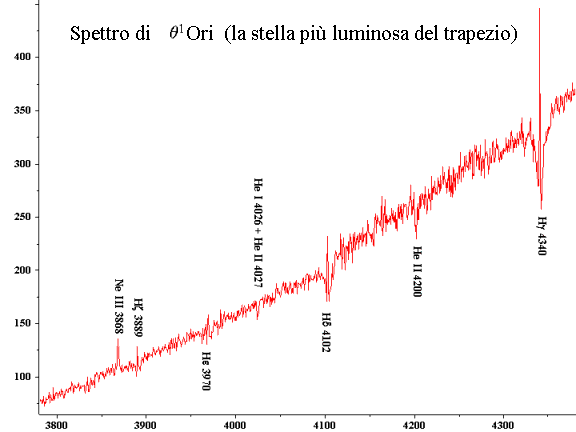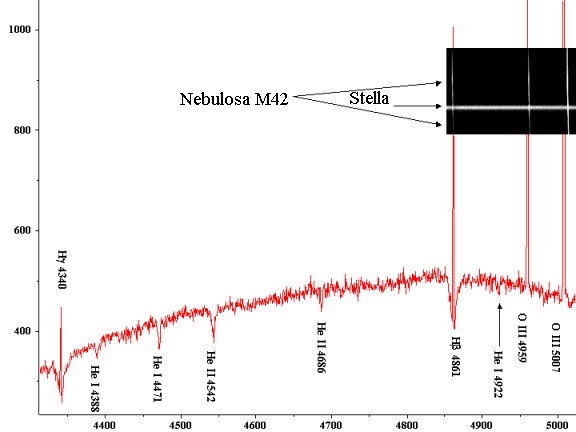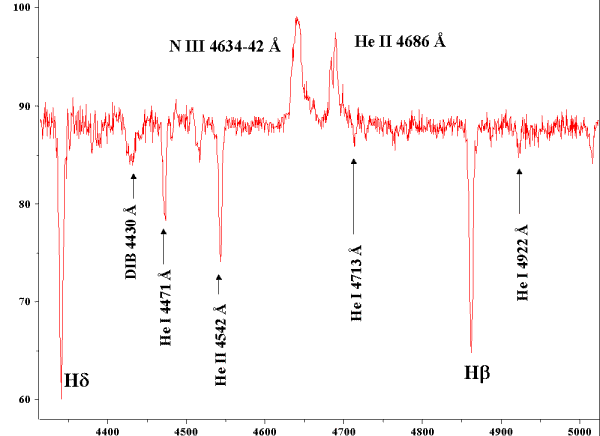NORMAL STAR SPECTRA
Spectral types:
O
- B
- A
- F
- G
- K
- M
Type O stars
Type O stars are a mere 0,00004% in number, but many of them are visible with the naked eye
because of their high luminosity.
Surface temperature ranges from 50000 K (type O3 extremely rare), 40000 K for type O5 and
down to 30000 K for O9.5 stars.
For O type stars, there is a very small difference between giant and main sequency stars
and the luminosity classes reduce often to the bare I and V without intermediate levels.
The following stars belong to O type:
z Ori (O9.5Ibe),
i Ori (O9),
l Ori (O8),
x Per (O7e),
q1 Ori (O6),
l Cep O6f.
Spectra contains very few lines (see pictures 1 and 2) due to the high ionisation level of metals.
Classification is done comparing the strenght of He I agains He II lines.
Emission lines are often present. In Oe stars emission lines are due to hydrogen, while in Of stars (see picture 3)
emission lines are due to NIII and He II at 4686 e 4640 ┼, thus connecting this subclass to
Wolf-Rayet stars.

|
Picture 1: Spectrum of q 1 Ori,
the brightest star in M42 trapezium. The range 3800-4100 ┼ has been recorded with
a 4 min exposure, from 4100 ┼ on the exposure was 2 min.
Spectrograph equipped with 1800 l/mm grating on 60 cm reflector F/20. Spectral resolution better than 1 ┼.
The broad absorbtion lines are due to the star while the sharp emissions are due to M42 nebula surrounding the star.
|

|
Picture 2: Spectrum of q 1 Ori,
the brightest star in M42 trapezium, from 4300 to 5000 ┼ with 2 min exposure.
Emission lines are due to M42 nebula (as shown in the insert with a portion of original CCD exposure)
sorrounding the star and are centered on broadened hydrogen stellar absorptions.
The ratio He I to He II lines determines the subclass. Instrument is the same as in picture 1.
|

|
Picture 3: Spectrum of l Cephei,
from 4100 to 5000 ┼ with 10 min exposure for each one of the three spectral windows necessary to fill the whole spectral range.
Dispersion is 0.6 ┼/pixel while spectral resolution is about 1 ┼.
Note the emission lines, probably due to outgoing shell of hot gas that produces large Doppler broadening of the lines.
It is also visibile the brightest of the Diffuse Interstellar Band (DIB) at 4430 ┼ due to the presence along
the line of sight of large interstellar clouds. The DIB absorption is a mere 5% of continuum intensity, this explains the noisy aspect
of this spectrum (see for other bands the intensity scale to the left).
|
Goto other spectral types:
B
- A
- F
- G
- K
- M
|
|



